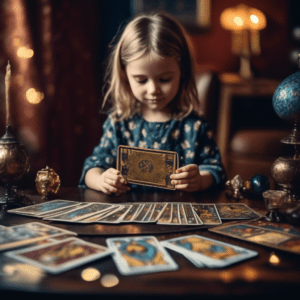Tarot cards have long been associated with mysticism and fortune-telling. However, there is a growing trend of parents introducing their children to tarot for self-reflection and personal development.
While some may question the appropriateness of exposing children to such practices, others argue that tarot can offer valuable insights and promote critical thinking skills. Let’s explore the pros and cons of children learning tarot and provide a balanced perspective on this controversial topic.
Quick Navigate This Post
Understanding Tarot and a History Lesson
The origin of tarot is a subject of much debate and speculation. While the exact origins are uncertain, tarot cards are believed to have originated in the 15th century in Europe, specifically in Italy and France. Initially, tarot cards were not used as a divination tool but as game-playing cards.
The earliest known tarot deck is the Visconti-Sforza deck, created in the 15th century for the Duke of Milan, Filippo Maria Visconti. This deck and other early tarot decks consisted of four suits similar to regular playing cards and additional trump cards.

The use of tarot cards for divination emerged in the 18th century. French occultist Jean-Baptiste Alliette, also known as Etteilla, is credited with popularizing tarot as a tool for divination. Etteilla published several books on tarot interpretation and developed his system for using the cards in divination.
In the late 19th and early 20th centuries, interest in tarot as a divination tool grew significantly with the rise of the occult and esoteric movements.
Prominent figures such as Arthur Edward Waite and Pamela Colman Smith collaborated on creating the Rider-Waite Tarot deck, one of today’s most widely used and influential tarot decks. This deck incorporated rich symbolism and imagery that made it more accessible for divinatory purposes.
Since then, numerous variations and interpretations of tarot decks have been created, each with unique symbolism and artistic style. Tarot has become a widely recognized and respected tool for divination, used by individuals seeking guidance, self-reflection, and insight into various aspects of their lives.
The exact reasons behind the transformation of tarot from a playing card game to a divination tool are still being determined. Some theories suggest that tarot cards’ symbolism and archetypal imagery resonated with individuals seeking spiritual and mystical guidance.
Others believe that the rise of esoteric movements and interest in the occult during the 18th and 19th centuries contributed to the shift in tarot’s purpose.
Regardless of its origins, tarot has become a powerful tool for self-exploration, personal growth, and divination, offering individuals a means to tap into their intuition and gain deeper insights into their lives and the world around them. That can benefit children too, which I will discuss soon.
Benefits of Children Learning Tarot

There are some benefits for children learning tarot; one is that they can develop emotional intelligence and learn to reflect to become self-aware.
So many of the older generations say that kids today are “brats” because it is believed that many times, they are coddled and are not given tools to help them regulate their emotions if they are having tantrums.
Some parents may be spoiling their kids, but most parents are doing their best and are unaware of the tools that can help their kids with emotional regulation, which is why they may give in.
However, tarot is an excellent tool for kids to self-reflect and help them regulate their emotions because it teaches you how to develop self-awareness.
They can use tarot to help them understand why they are upset about something and be able to communicate it with a trusted adult such as a teacher, a more nurturing parent, or a beloved extended family member to validate them and also give them tips to work through it. That is how the tarot can help enhance emotional intelligence and self-awareness in children.
Critical Thinking and Decision-Making Skills
Tarot can be a valuable tool to help develop critical thinking skills in children as they are rich in symbolism and imagery.
By encouraging children to interpret the symbols and images on the cards, they can learn to think critically and analyze different meanings and associations. This practice enhances their ability to perceive and interpret abstract concepts.
Tarot readings often involve asking questions and reflecting on the responses. This process encourages children to think critically about their questions and consider various perspectives and possibilities.
They learn to formulate thoughtful questions and reflect on the answers they receive, promoting analytical thinking.
Tarot can assist children in developing decision-making skills. Children can use tarot cards to explore each option’s potential outcomes and consequences when faced with choices.
This exercise helps them critically analyze the situation, weigh the pros and cons, and make informed decisions based on their interpretations of the cards.
Tarot can be used as a problem-solving tool. Children can apply critical thinking to identify challenges or obstacles and then utilize tarot to explore potential solutions or strategies. This process encourages them to think creatively, consider alternatives, and develop problem-solving abilities.
Empowerment and Self-Expression

Tarot encourages children to tap into their intuition and trust their instincts. Children learn to rely on their inner wisdom and develop their gut feelings by exploring their intuitive responses to the cards. This practice enhances their critical thinking abilities by incorporating logical analysis and intuitive insights.
Tarot exposes children to various symbols, themes, and archetypes. This exposure encourages them to think critically and embrace different perspectives and ideas.
They develop open-mindedness and empathy as they explore the multiple interpretations and meanings associated with the cards, fostering their critical thinking skills. However, there are also concerns regarding children reading tarot, as there are considerations to make before you hand them any deck.
Potential Concerns and Considerations
When it comes to children using tarot, several potential concerns and considerations should be taken into account:
Tarot cards often contain complex symbolism and themes that may not be suitable for young children. It is essential to consider the age and maturity level of the child before introducing them to tarot.
Younger children may have difficulty understanding and interpreting the symbolism, while older children may be better equipped to engage with the cards meaningfully.
Children should always have parental guidance and supervision when using tarot cards. Parents can help explain the meanings and symbols, guide the child’s interpretations, and ensure a responsible and educational approach to tarot. Parents need to be actively involved and supportive throughout the process.
Tarot readings can sometimes evoke strong emotions and feelings in individuals. Children may not have the emotional maturity or coping skills to process and deal with these intense emotions.
Creating a safe and supportive environment where children feel comfortable expressing their emotions and discussing their experiences with tarot is crucial.
Tarot has a history rooted in various belief systems, including occult and esoteric practices. Considering the child’s and family’s beliefs and values before introducing tarot is essential. Some families may have religious or cultural beliefs that conflict with or discourage the use of tarot. Respecting and honoring these beliefs is critical.
Children have active imaginations, and it is essential to help them understand the difference between the symbolic world of tarot and real-life situations. They should be guided to see tarot as a tool for self-reflection and personal growth rather than predicting the future or relying solely on divination.
Tarot readings should be conducted with ethical considerations, even when involving children. It is important to emphasize that tarot is not a tool for manipulation, coercion, or making decisions on behalf of others. Children should be encouraged to use tarot responsibly and respectfully, focusing on their personal growth and understanding.
Children should be taught to establish and respect personal boundaries regarding tarot. They should understand that tarot readings are personal and private, and they can decline to participate or share their readings with others if they feel uncomfortable.
Practical Tips for Introducing Tarot to Children

When introducing tarot to children, it is essential to approach it responsibly and age-appropriately. There are some practical tips to consider.
Consider the age and maturity level of the child. Younger children may benefit from simplified versions of tarot decks, while older children may be able to engage with more complex symbolism. Choose a deck that aligns with their development stage.
Take the time to educate the child about the history and purpose of tarot. Explain that it is a tool for self-reflection and personal growth, not a way to predict the future. Please provide a brief overview of the different cards and their meanings.
Begin with simple tarot spreads that are easy for children to understand. For example, a one-card or three-card spread can be a good starting point. As the child becomes more comfortable, you can introduce more complex spreads.
Encourage the child to interpret the cards based on their intuition and feelings. Ask open-ended questions that prompt them to explore the symbolism and meanings of the cards. Avoid giving them rigid interpretations and allow them to develop their understanding.
Create a safe and supportive environment where the child feels comfortable expressing their thoughts and emotions. Encourage open dialogue and active listening. Let the child know there are no right or wrong answers regarding tarot interpretations.
Tarot can be a valuable tool for self-reflection. Encourage the child to reflect on their experiences, emotions, and aspirations as they interpret the cards. Help them see tarot as a means of gaining insights into themselves and their personal growth.
Highlight the positive aspects of tarot, such as self-discovery, personal empowerment, and creativity. Encourage the child to see tarot as a tool for personal exploration and understanding rather than a source of fear or negativity.
Teach the child about personal boundaries when it comes to tarot. Let them know that their tarot readings are personal and private, and they can keep them to themselves if they wish. Respect their boundaries and encourage them to respect the boundaries of others.
If you have experience with tarot, lead by example. Share your tarot practices and experiences with the child. Demonstrate how you use tarot for self-reflection and personal growth.
Make tarot enjoyable for the child. Please encourage them to use their creativity in interpreting the cards and exploring different spreads. Incorporate playful activities, such as creating tarot cards or using tarot for storytelling.
Remember, the goal is to provide a positive and educational experience for the child. Adapt the introduction of tarot to their needs and interests, and always prioritize their well-being and understanding.
While the idea of children learning tarot may initially raise eyebrows, it is essential to objectively consider the potential benefits and drawbacks.
Tarot can provide children valuable tools for self-reflection, critical thinking, and self-expression. However, addressing concerns regarding appropriateness, misinterpretation, and cultural sensitivities is equally essential.
Ultimately, the decision to introduce tarot to children should be made with careful consideration, parental guidance, and respect for individual beliefs and values.
If you want to dive deeper into the world of tarot, raw spirituality, and mental health, subscribe to my Substack and be part of a great community!

